Dynamic wind turbine models in
power system simulation tool
DIgSILENT
Anca D. Hansen, Florin Iov, Poul Sørensen, Nicolaos
Cutululis, Clemens Jauch, Frede Blaabjerg
Risø-R-1400(ed.2)(EN)
Risø National Laboratory
Technical University of Denmark
Roskilde, Denmark
August 2007
�
Author: Anca D. Hansen, Florin Iov, Poul Sørensen, Nicolaos
Cutululis, Clemens Jauch, Frede Blaabjerg
Title: Dynamic wind turbine models in power system simulation tool
DIgSILENT
Department: Wind Energy Department
Abstract (max. 2000 char.):
This report presents a collection of models and control strategies
developed and implemented in the power system simulation tool
PowerFactory DIgSILENT for different wind turbine concepts. It is
the second edition of Risø-R-1400(EN) and it gathers and describes
a whole wind turbine model database built-op and developed during
several national research projects, carried out at Risø DTU National
Laboratory for Sustainable Energy and Aalborg University, in the
period 2001-2007. The overall objective of these projects was to
create a wind turbine model database able to support the analysis of
the interaction between the mechanical structure of the wind turbine
and the electrical grid during different operational modes.
The report provides thus a description of the wind turbines
modelling, both at a component level and at a system level. The
report contains both the description of DIgSILENT built-in models
for the electrical components of a grid connected wind turbine (e.g.
induction generators, power converters, transformers) and the
models developed by the user, in the dynamic simulation language
DSL of DIgSILENT, for the non-electrical components of the wind
turbine (wind model, aerodynamic model, mechanical model). The
initialisation issues on the wind turbine models into the power
system simulation are also presented.
The main attention in the report is drawn to the modelling at the
system level of the following wind turbine concepts:
1. Fixed speed active stall wind turbine concept
2. Variable speed doubly-fed induction generator wind
turbine concept
3. Variable speed multi-pole permanent magnet synchronous
generator wind turbine concept
These wind turbine concept models can be used and even extended
for the study of different aspects, e.g. the assessment of power
quality, control strategies, connection of the wind turbine at
different types of grid and storage systems. Different control
strategies have been developed and implemented for these wind
turbine concepts, their performance in normal or fault operation
being assessed and discussed by means of simulations. The
described control strategies have different goals e.g. fast response
over disturbances, optimum power efficiency over a wider range of
wind speeds, voltage ride-through capability including grid support.
A dynamic model of a DC connection for active stall wind farms to
the grid including the control is also implemented and presented.
Risø-R-1400(ed.2)(EN)
August 2007
ISSN 0106-2840
ISBN 978-87-550-3553-9
Contract no.:
ENS 1363/04-0008
Group's own reg. no.:
1115043-01
Sponsorship:
Cover :
Pages: 190
Tables: 7
References: 74
Information Service Department
Risø National Laboratory
Technical University of Denmark
P.O.Box 49
DK-4000 Roskilde
Denmark
Telephone +45 46774004
bibl@risoe.dk
Fax +45 46774013
www.risoe.dk
�
Contents
Preface 6
1
Introduction 7
Squirrel cage induction generator (SCIG) 11
Doubly-fed induction generator (DFIG) 13
Synchronous generator 15
2 Wind turbine modelling in DIgSILENT 8
2.1 Power system simulation tool - DIgSILENT 8
2.2 Grid component built-in models in DIgSILENT 9
2.2.1 Electrical machinery 10
2.2.1.1
2.2.1.2
2.2.1.3
2.2.2 Power converters 18
2.2.3 Transformer 23
2.3 DSL models of wind turbine in DIgSILENT 24
2.3.1
2.3.2 Mechanical model 28
2.3.3 Aerodynamic model 31
2.3.4 Wind model 36
2.3.5 Capacitor-bank control model 38
2.4 Combined heat and power plant 39
Initialisation issues on the wind turbine DSL models 26
Generating θ lookup table 46
3 Fixed speed active stall wind turbine concept with AC connection –
with traditional power controller 43
3.1 Active Stall Control Strategy 43
3.1.1 Power Limitation 44
3.1.2 Power Optimisation 44
3.1.3 Transition between power limitation and power optimisation mode 45
3.2 Traditional power controller 45
3.2.1 Power optimisation 45
3.2.1.1
3.2.2 Power limitation 47
3.2.3 Transition between optimisation and limitation 48
3.2.4 Pitch angle control system 49
3.2.4.1
3.2.4.2
3.3 Wind turbine controller implementation in power system simulation tool
52
3.3.1 Power optimisation 53
3.3.2 Power limitation 54
3.4 Simulations 55
3.4.1 Parameter Settings 55
3.4.2 Power optimisation 56
3.4.3 Transition between optimisation and limitation 57
3.4.4 Power limitation 58
4 Fixed speed active stall wind turbine concept with AC connection –
with grid support power controller 60
4.1 Grid support active power controller 61
Subsystem to avoid unnecessary pitching 51
Overpower protection 52
Risø-R-1400/Second Edition (EN)
3
�
4.2 Grid support reactive power controller 65
4.3 Simulations 66
5 Fixed speed active stall wind turbines with HVDC/VSC connection 69
5.1 Control for Station A (sending end station) 71
5.2 Control for Station B (receiving end station) 73
5.3 System overview 76
5.4 Simulation results 77
5.4.1 Case A 77
5.4.2 Case B 80
5.4.3 Different frequency drop coefficients 84
5.4.4
6 Variable speed wind turbine concepts 89
Island operation 86
7 Variable speed DFIG wind turbine concept – normal operation 92
7.1 The overall control system of a variable speed wind turbine with DFIG 94
7.2 DFIG control 97
7.2.1 System reference frames 97
7.2.2 Control configuration of DFIG in DIgSILENT 99
7.2.3 Rotor-side converter control 100
7.2.4 Grid-side converter control 102
7.3 DFIG wind turbine control strategy I 104
7.3.1 Speed controller (I) 108
7.3.2 Power controller (I) 109
7.3.3 Cross-coupled control 111
7.3.4 Simulation results (I) 111
7.4 DFIG wind turbine control strategy II 116
7.4.1 Speed controller (II) 118
7.4.2 Power controller (II) 120
7.4.3 Simulation results (II) 120
8 Variable speed DFIG wind turbine concept – grid fault operation 127
8.1 DFIG wind turbine modelling and control issues – in case of grid fault 128
8.1.1 Drive train, aerodynamics and pitch angle control system 129
8.1.2 DFIG protection system during grid faults 130
8.1.3 DFIG control system during grid faults (fault ride-through control) 133
8.2 Voltage grid support of DFIG wind turbine 136
8.3 Case studies 140
8.3.1 Aggregation method 140
8.3.2 Power system test model 141
8.3.3 Simulation Examples 142
8.3.3.1
143
8.3.3.2
9 Variable speed multi-pole PMSG wind turbine concept 150
9.1 Multi-pole (direct-driven) wind turbine generators 150
9.2 System configuration of variable speed multi-pole PMSG wind turbine 151
9.3 Gearless drive train, aerodynamics and pitch angle control system 153
Dynamic interaction of DFIG wind turbines and power system
Voltage grid support of DFIG wind turbines 145
4
Risø-R-1400/Second Edition (EN)
�
9.4 Permanent magnet synchronous generator (PMSG) model 156
9.5 Full-scale frequency converter configuration 158
9.5.1 Generator-side converter 158
9.5.2 DC-link 160
9.5.3 Grid-side converter 160
9.6 Full-scale frequency converter control 161
9.6.1 System reference frames 161
9.6.2 Overall control strategy of PMSG with full-scale converter 162
9.6.3 Damping system 163
9.6.4 Converter control strategy 169
9.7 Simulations results 172
9.7.1 System performance under deterministic wind speeds 173
9.7.2 System performance under stochastic wind speeds 176
9.7.3 Voltage controller effect 178
10 CONCLUSIONS 179
Acknowledgements 183
REFERENCES 184
Risø-R-1400/Second Edition (EN)
5
�
Preface
This report describes the modelling and control work carried out during two
projects, i.e. “Simulation platform for modelling, optimization and design of
wind turbines”, and "Electrical Design and Optimisation of Wind Turbines".
These projects, carried out in a cooperation between Risø DTU National Labo-
ratory for Sustainable Energy and Aalborg University, were funded by the Dan-
ish Energy Agency contract numbers ENS 1363/04-0008 and ENS-1363/01-
0013.
6
Risø-R-1400/Second Edition (EN)
�
1 Introduction
The present report describes the dynamic wind turbine models imple-
mented in the power system simulation tool DIgSILENT, which provides both
an extensive library for grid components and a dynamic simulation language
(DSL) for the modelling of each wind turbine component. The development of
these models is a part of the results of a national Danish research project, whose
overall objective is to create a model database of electrical components mainly,
in different simulation tools in order to enhance the design and the optimisation
of the wind turbines.
The developed model database is able to support the analysis of the interac-
tion between the mechanical structure of the wind turbine and the electrical grid
both during normal operation of the wind turbine and during transient grid fault
events. Such models make it possible to simulate the dynamic interaction be-
tween a wind turbine/wind farm and a power system. They enable both the po-
tential wind turbine owners and the grid utility technical staff to perform the
necessary studies before investing and connecting wind turbines (farms) to the
grid. Simulation of the wind turbine interaction with the grid may thus provide
valuable information and may even lower the overall grid connection costs.
The motivation for this research work is the ever-increasing wind power
penetration into power networks. In recent years the trend has been moved from
installations with a few wind turbines to the planning of large wind farms with
several hundred MW of capacity. This increased and concentrated penetration
makes the power network more dependent on, and vulnerable to, the wind en-
ergy production. This situation means that future wind farms must be able to
replace conventional power stations, and thus be active controllable elements in
the power supply network. In other words, wind farms must develop power
plant characteristics (Sørensen P. et al., 2000). The two utilities responsible for
the transmission systems in Denmark, Eltra and Elkraft System, have issued
requirements (Eltra, 2000) that focus on the influence of wind farms on grid
stability and power quality, and on the control capabilities of wind farms.
Another consequence of the increased future size of wind farms is that the
large wind farms will be connected directly to the high voltage transmission
grid. Until now, wind turbines and wind farms have been connected to the dis-
tribution system, which typically has either 10/20 kV or 50/60 kV grids. There-
fore, the main focus has been on the influence of the wind farms on the power
quality of the distribution system. For example in Denmark, this has been regu-
lated by the Danish Utilities Research Institute (DEFU) requirements for grid
connection of wind turbines to the distribution system (DEFU, 1998). However,
the transmission system operators in Denmark now issue more strict connection
requirements for large wind farms if they are connected directly to the transmis-
sion system. Moreover, national standards for power quality of wind turbines
have recently been supplemented by a new standard for measurement and as-
sessment of power quality of grid connected wind turbines, namely (IEC 61400-
21,2001).
A large part of the report is dedicated to the modelling and control of three
wind turbine concepts, namely:
1. Fixed speed active stall wind turbine concept
Risø-R-1400/Second Edition (EN)
7
�
2. Variable speed doubly-fed induction generator wind turbine concept
3. Variable speed multi-pole permanent magnet synchronous generator
wind turbine concept
The report is organised as follows. First, the power system simulation tool
DIgSILENT is shortly described. Then the wind turbine modelling in DIgSI-
LENT is presented. The modelling and control of the mentioned wind turbine
concepts in the power simulation tool DIgSILENT are then presented, their per-
formance being assessed and analysed by means of simulations. Different con-
trol strategies are presented and designed for both normal and fault operation,
based on goals such as fast response over disturbances, optimum power effi-
ciency over a wider range of wind speeds, voltage ride-through and grid support
capabilities.
2 Wind turbine modelling in DIg-
SILENT
After a short description of the power system simulation tool, the goal of this
chapter is to describe the wind turbine modelling in DIgSILENT at component
level, namely the modelling of each wind turbine component.
2.1 Power system simulation tool - DIgSILENT
The increasing capacity of wind power penetration is one of today’s most chal-
lenging aspects in power-system control. Computer models of power systems
are widely used by power-system operators to study load flow, steady state
voltage stability, dynamic and transient behaviour of power systems. Today
these tools must incorporate extensive modelling capabilities with advanced
solution algorithms for complex power-system studies, as in the case of wind
power applications. An example of such a tool is the power system simulation
tool DIgSILENT (DIgSILENT, 2006).
DIgSILENT has the ability to simulate load flow, RMS fluctuations and
transient events in the same software environment. It provides models on a dif-
ferent level of detailing. It combines models for electromagnetic transient simu-
lations of instantaneous values with models for electromechanical simulations
of RMS values. This makes the models useful for studies of both (transient)
grid fault and (longer-term) power quality and control issues.
DIgSILENT provides a comprehensive library of models of electrical
components in power systems. The library includes models of e.g. generators,
motors, controllers, dynamic loads and various passive network elements (e.g.
lines, transformers, static loads and shunts). Therefore, in the present work, the
grid model and the electrical components of the wind turbine model are in-
cluded as standard components in the existing library. The models of the wind
speed, the mechanics, aerodynamics and the control systems of the wind tur-
bines are written in the dynamic simulation language DSL of DIgSILENT. The
DSL makes it possible for users to create their own blocks either as modifica-
tions of existing models or as completely new models. These new models can
be collected into a library, which can be easily used further in the modelling of
other wind farms with other wind turbines.
8
Risø-R-1400/Second Edition (EN)
�
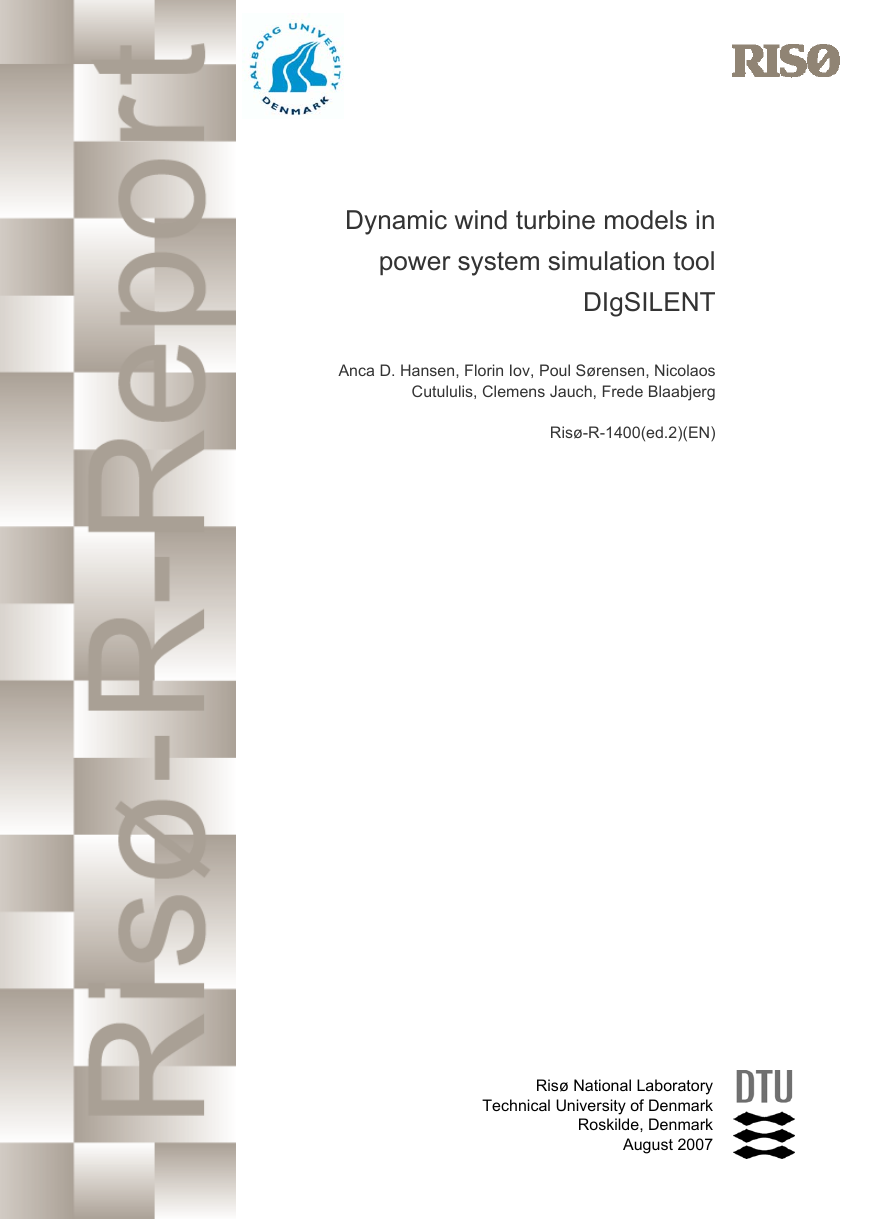
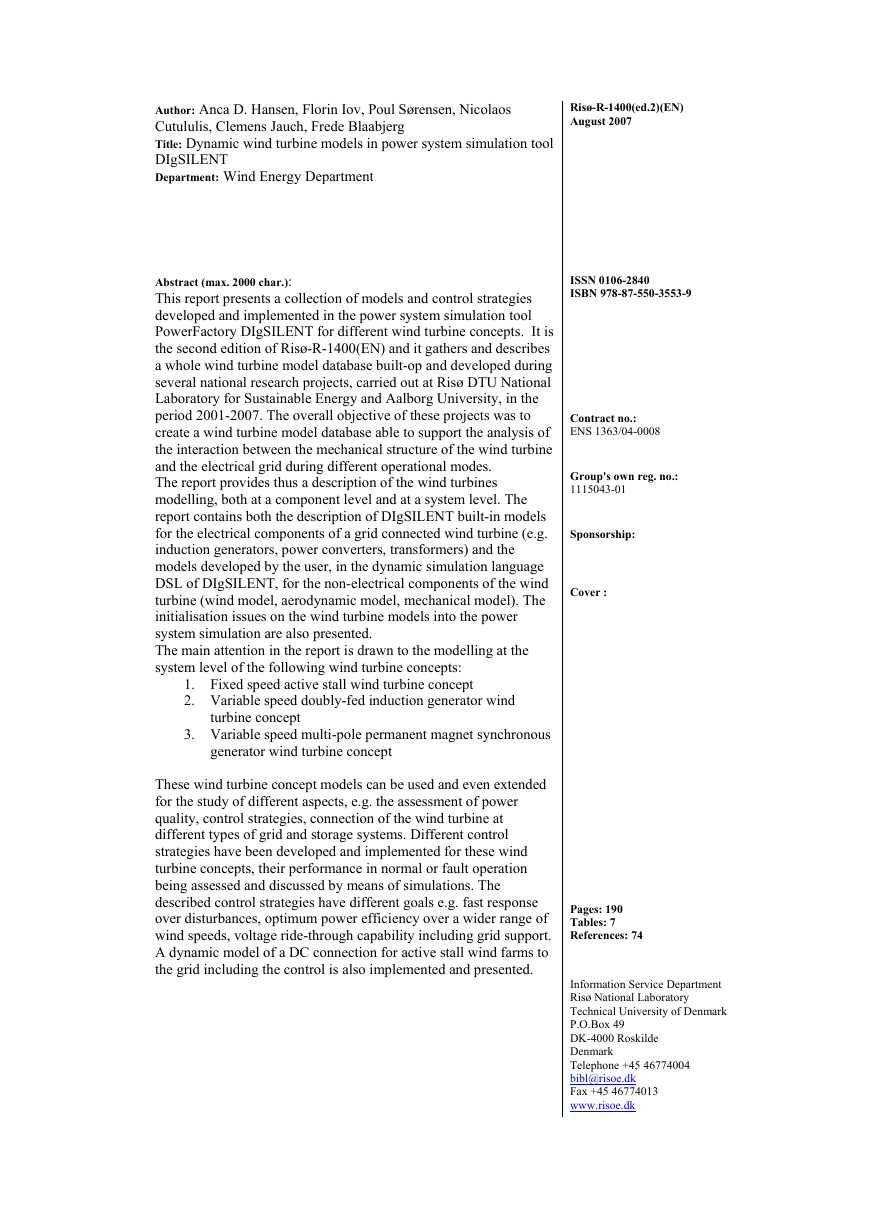
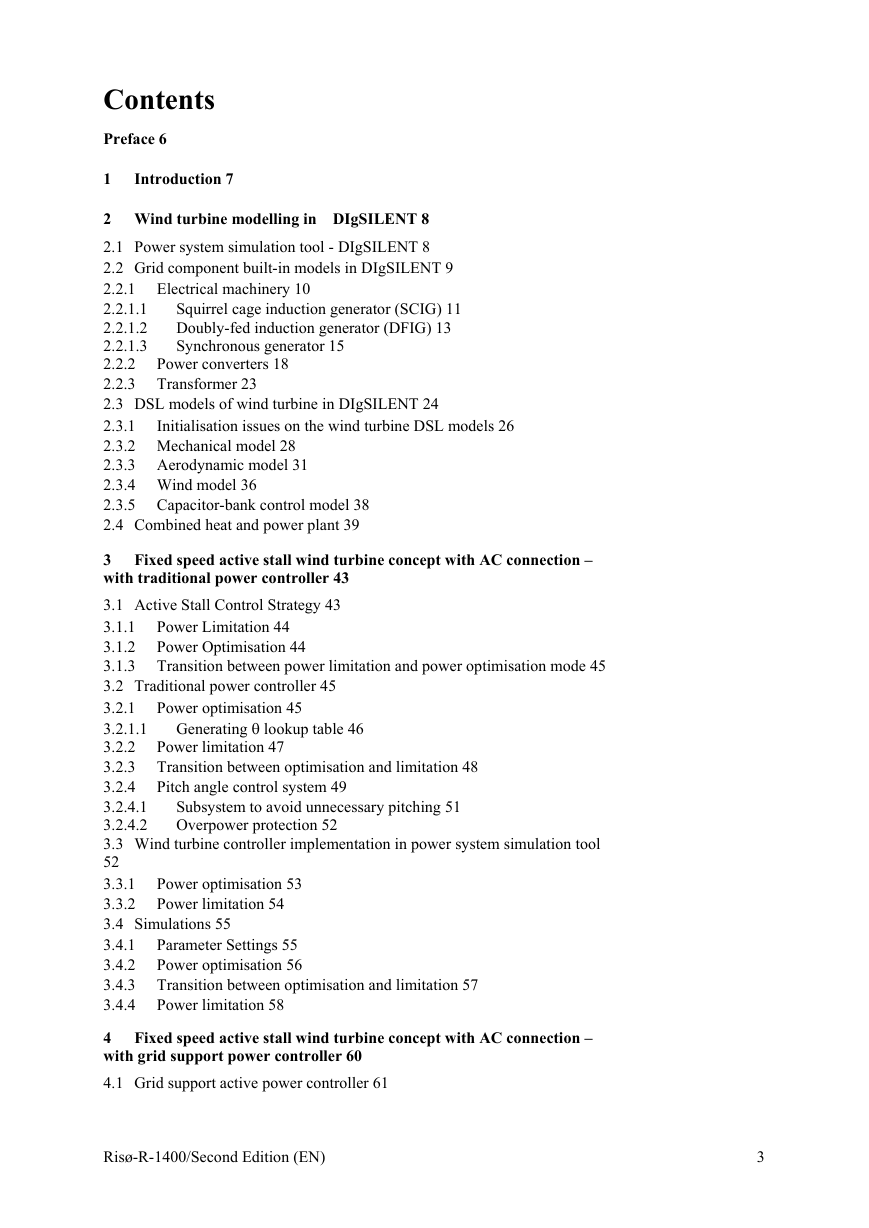
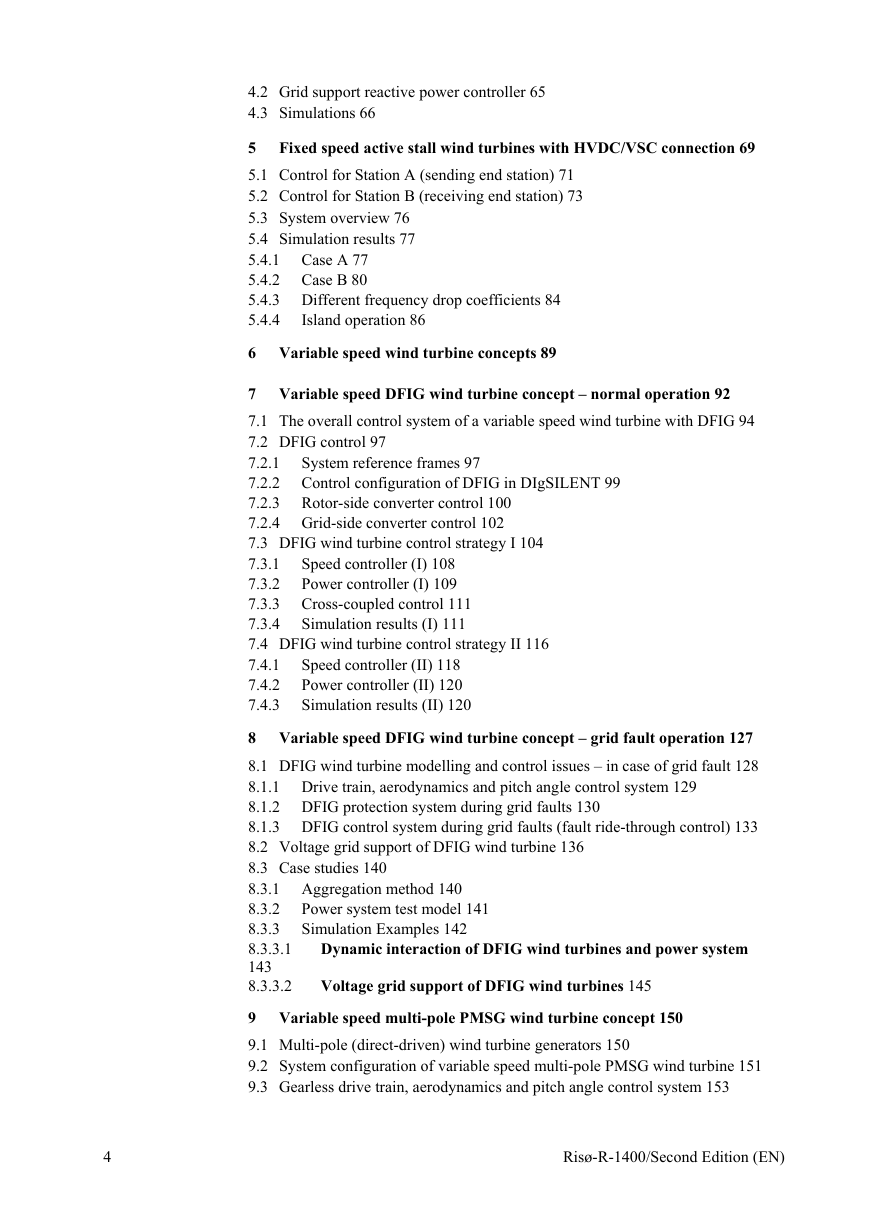
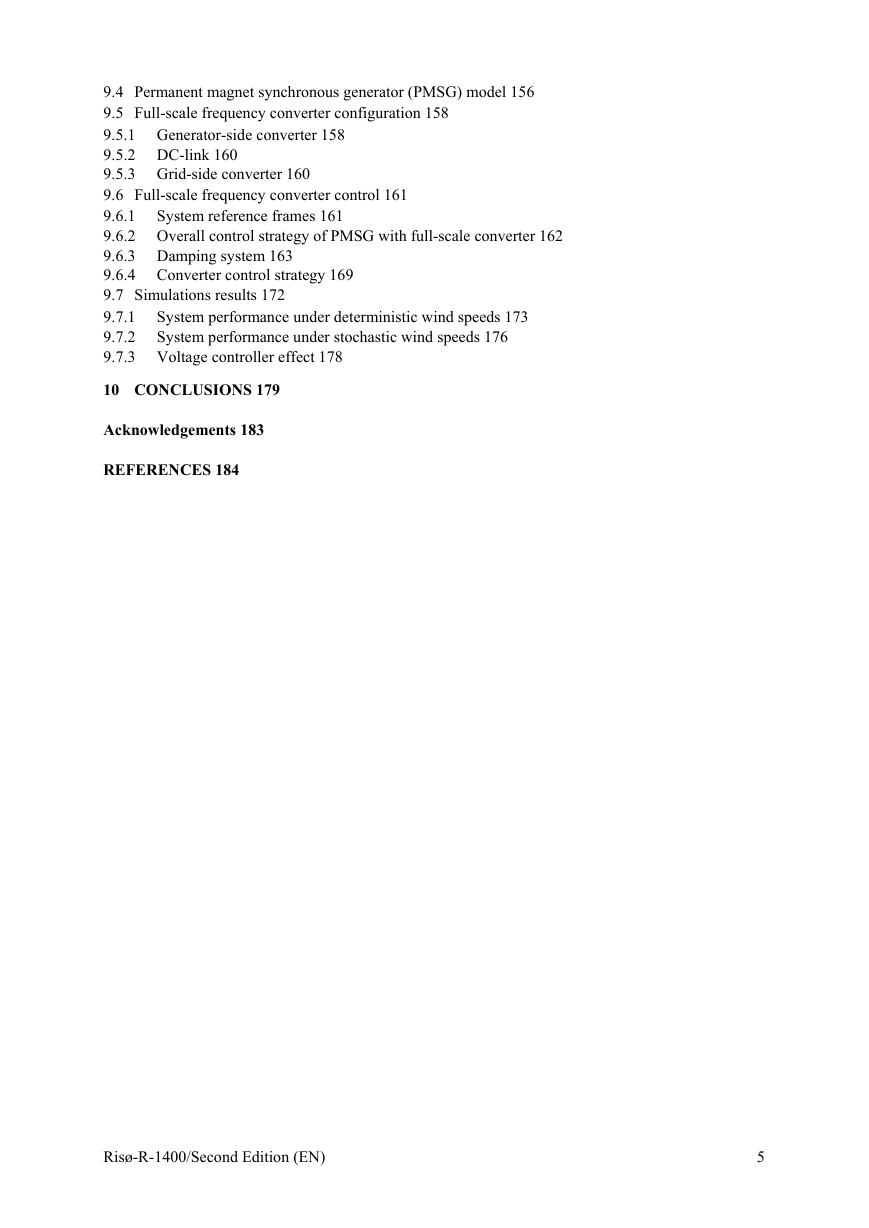
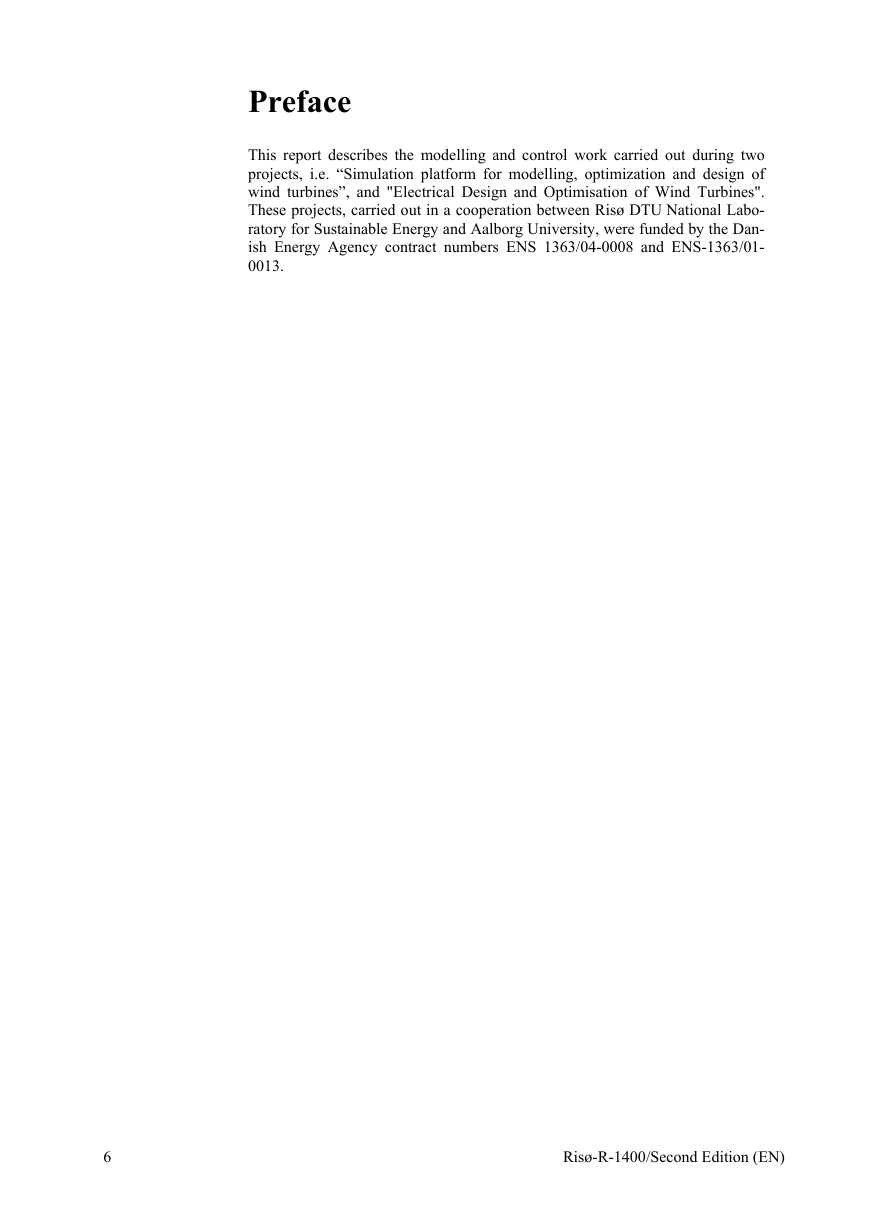
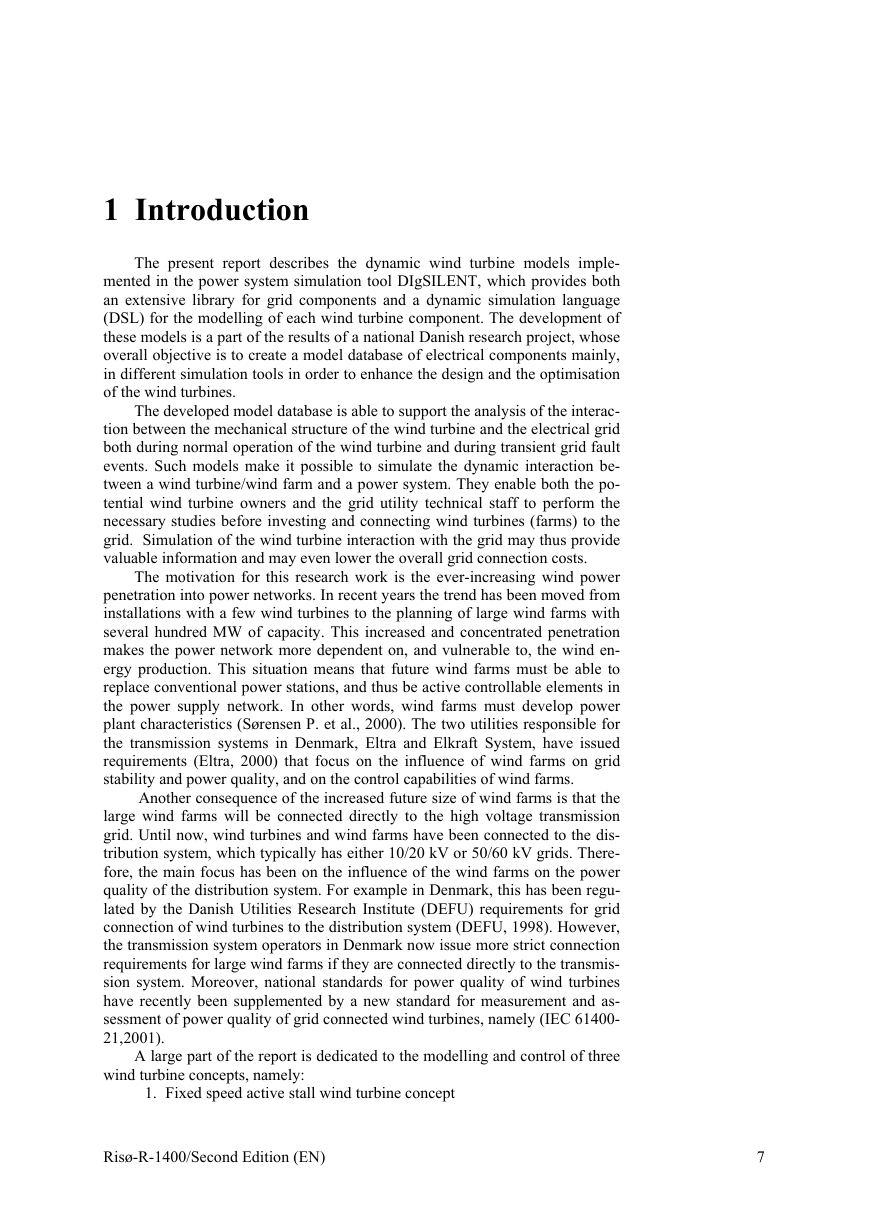









 2023年江西萍乡中考道德与法治真题及答案.doc
2023年江西萍乡中考道德与法治真题及答案.doc 2012年重庆南川中考生物真题及答案.doc
2012年重庆南川中考生物真题及答案.doc 2013年江西师范大学地理学综合及文艺理论基础考研真题.doc
2013年江西师范大学地理学综合及文艺理论基础考研真题.doc 2020年四川甘孜小升初语文真题及答案I卷.doc
2020年四川甘孜小升初语文真题及答案I卷.doc 2020年注册岩土工程师专业基础考试真题及答案.doc
2020年注册岩土工程师专业基础考试真题及答案.doc 2023-2024学年福建省厦门市九年级上学期数学月考试题及答案.doc
2023-2024学年福建省厦门市九年级上学期数学月考试题及答案.doc 2021-2022学年辽宁省沈阳市大东区九年级上学期语文期末试题及答案.doc
2021-2022学年辽宁省沈阳市大东区九年级上学期语文期末试题及答案.doc 2022-2023学年北京东城区初三第一学期物理期末试卷及答案.doc
2022-2023学年北京东城区初三第一学期物理期末试卷及答案.doc 2018上半年江西教师资格初中地理学科知识与教学能力真题及答案.doc
2018上半年江西教师资格初中地理学科知识与教学能力真题及答案.doc 2012年河北国家公务员申论考试真题及答案-省级.doc
2012年河北国家公务员申论考试真题及答案-省级.doc 2020-2021学年江苏省扬州市江都区邵樊片九年级上学期数学第一次质量检测试题及答案.doc
2020-2021学年江苏省扬州市江都区邵樊片九年级上学期数学第一次质量检测试题及答案.doc 2022下半年黑龙江教师资格证中学综合素质真题及答案.doc
2022下半年黑龙江教师资格证中学综合素质真题及答案.doc